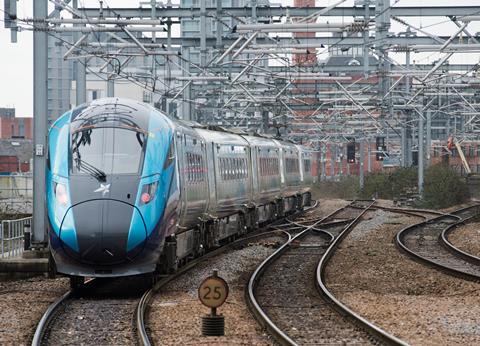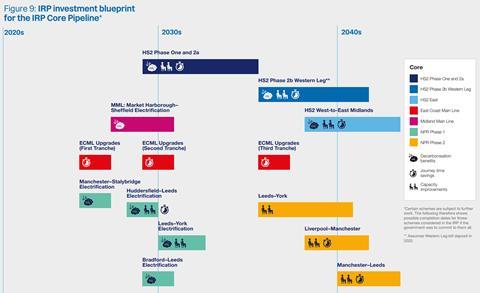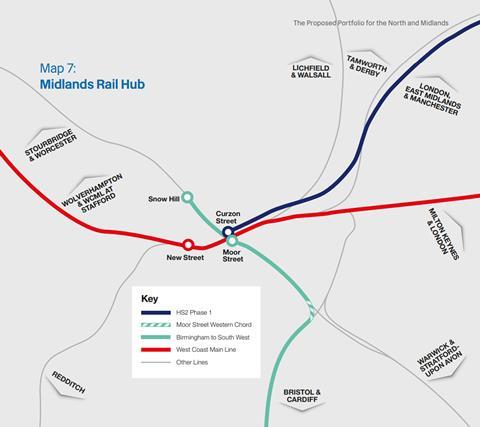
UK: Speaking on condition of anonymity, sources within the Department for Transport have defended decisions taken during the creation of the Integrated Rail Plan for the North & Midlands.
Lengthy timescales

Criticism has been directed at the apparently lengthy project timescales set out in the IRP which was published on November 18, but DfT sources say these represent anticipated completion dates, rather than the duration of each project.
Despite this, some completion dates look concerning, such as electrification of the 13 km between Manchester Victoria and Stalybridge which is already underway and for which most of the preparatory work has been carried out. According to IRP, this is likely be completed some time after mid-2024, representing a work rate of less than 5 km a year. A DfT source confirmed to Rail Business UK that it was anticipating ‘2024 to 2026’ as the range for completion.
Given this rate of progress, electrification of the full trans-Pennine route is unlikely to be finished until 2030-32; work to deliver the Midlands Rail Hub would follow in the late 2030s.
DfT has defended this by suggesting that more planning and design work is required before the Transport & Works Act process can begin, and insists that work will still be delivered ‘more quickly than by any other approach’.
HS2 and NPR
The completion of the sections of new alignment for Northern Powerhouse Rail between Warrington and east of the Standedge tunnels is scheduled for the mid-2040s, as the project’s critical path depends on the completion of the HS2 Phase 2b Western Leg between Crewe and Manchester Piccadilly, which has also seen its completion date slip.
DfT remains confident that the proposed HS2 terminus at Manchester Piccadilly remains the best solution, suggesting that Transport for the North’s preference for a sub-surface through station would add several years to the planning and construction process, increase costs and lead to unacceptable disruption.
Advice from planners and HS2 Ltd to DfT indicates that taking into account timetabling and the different service groups, the HS2 route into Manchester from Manchester Airport — where it would be joined by the NPR line from Warrington — could handle up to 14 trains/h, and that the proposed surface station would be able to manage this level of service.
The NPR line to Standedge would be accessed by another tunnel, with grade separation on the approaches to the joint HS2/NPR station at Manchester Piccadilly to ensure there are no capacity-reducing crossing moves.
DfT confirms that new tunnelling will be needed to take the NPR line to the eastern end of the Standedge tunnels, but it is too soon to confirm whether this will involve re-boring the existing pair of redundant southern single-track bores or brand new tunnels.
To the west, DfT feels that there is sufficient spare capacity on the four-track section of the WCML between Ditton and Liverpool Lime Street to accommodate the additional NPR and HS2 services, although it suggests that Network Rail may need to do more work to deal with the number of low speed junctions used by freight trains on that part of the route.
DfT accepts that work will needed at Liverpool Lime Street to handle additional services. A plan is still to be decided, but future-proofing is very much in mind and it could included construction of additional platforms in the car park to the south of the trainshed.
DfT is also happy with the modelling carried out by Network Rail which suggests that a 10 min journey time from the new station below Warrington Bank Quay station to Manchester Airport can be achieved. DfT is not ready to release details of how far tracks will be laid on the existing abandoned trackbed to the east of Warrington before they take up a new route to Manchester Airport. Officials remain hopeful that very high speeds will be possible on the line and says that services coming off HS2 onto the NPR link to Warrington ‘will do so at line speed’.
This would also be the route used by HS2 services from London to Liverpool, serving a rebuilt Crewe station en route; this could facilitate portion working of HS2 services to Liverpool and Lancaster.
Preston plan
The pausing of the plan to construct the Golborne spur that would take HS2 north from Crewe to meet the WCML south of Wigan is related to proposals contained in the Union Connectivity Review released on November 26, which suggested that a link between HS2 and the WCML nearer to Preston may be revisited.
DfT says that this could see Anglo-Scottish trains using part of the NPR line between Manchester Airport and Warrington before joining another section of HS2 to reach Preston; further details are to be published in due course.
DfT accepts freight capacity across the Pennines is not immediately addressed by IRP, which notes that infrastructure schemes will be critical in creating freight paths. It recognises that the Rail Freight Group and other freight advocates may not be happy, but officials believe that while some work may be delivered by 2030, further improvements ‘will require land take and sections of three-or four-tracking’ over the longer term.
Aspirational words
Responding to observations that IRP includes many aspirational references to ‘could’, which suggest that even those welcoming the plan enthusiastically could be disappointed. DfT’s defence is that this allows for further reviews.

Looking specifically at the Midlands Hub proposals, IRP has removed some elements such as the Moor Street Eastern Chord which would have enabled services from the East Midlands to run into Birmingham Moor Street and Snow Hill stations rather than the congested New Street. DfT insists that the hub’s business case is to be reviewed again in the light of other IRP proposals ‘before the “could” becomes a “will”’.
Local interventions to address capacity problems around Manchester are not within the scope of IRP, instead forming part of the work being undertaken separately by the Manchester Task Force. More details of the project pipeline will be announced in due course.
DfT sources confirm that the planned electrification of the Midland Main Line to Sheffield brings wiring of the Hope Valley line between Manchester and Sheffield into focus as a long-term aspiration; further electrification of this and other corridors, including the Leeds – Hull route, is backed by the National Infrastructure Commission.
East Coast Main Line
Finally, DfT confirms that aspirations for improving speeds on the East Coast Main Line will be achieved through ‘quite a lot of interventions’, including grade separation of more junctions and deployment of digital signalling.
DfT’s outline proposals for ECML enhancements cover three tranches of work, some to deliver quick short-term gains, more in the run-up to 2030 and then a set of major interventions through the 2030s.
Schemes proposed by Mott MacDonald in its advice to DfT include expanding the roll-out of digital traffic management and ETCS, grade separation at Newark, construction of freight avoiding lines at Doncaster and four tracking at Welwyn. However, the latter would not cover the double-track bottleneck at the viaduct and tunnel north of the town, which DfT is ‘not proposing to touch’.
This ECML package builds on work originally done by Network Rail related to achieving a 4 h journey time between London and Edinburgh in 4 h. This has been reassessed in light of IRP, recognising that some of the L2E4 targets are to be met in an upcoming timetable recast without any infrastructure work. The future interventions ‘give the chance to go further’ says DfT, and this work stream is now being further refined as the starting point of a formal Network Rail development project.



